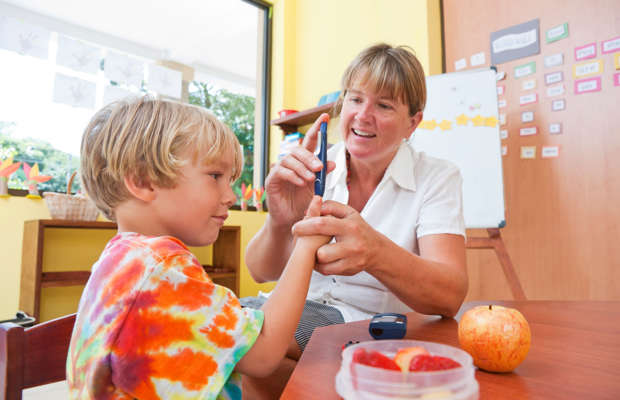© (Getty Images)Parents of children with diabetes can set up an individual 504 Plan with the school to ensure safety and accessibility.
Packing health supplies is just part of being prepared.
Brooke Yost of St. Louis, Missouri, is starting seventh grade in style. Insulin, needles, testing strips, a glucagon kit for low blood sugar – all fit into her colorful floral bag. Adding a couple of snack items and a juice box, 12-year old Brooke is good to go. She'll carry her medical bag from classes to the gym to the cafeteria, just as she's done since kindergarten to
manage her Type 1 diabetes.
With Type 1 diabetes, the pancreas fails to make insulin, an essential hormone that keeps glucose levels, or blood sugar, steady within the body. Type 1 diabetes can cause long-term damage to the eyes, nerves, kidneys and other organs if left untreated.
Of more
immediate concern are sudden episodes of dangerously low blood sugar, or hypoglycemia. Food, exercise, health issues and stress all affect the delicate balance between multiple daily insulin injections and fluctuating blood sugar levels.
Even for the most organized adults, staying on top of Type 1 diabetes is a challenge. For kids with diabetes and their parents, starting the new school year is a project in itself. The following steps help kids realize their
complete school experience while staying safe:
© Chris Fertnig/E+/Getty Images
Put your medical plan together. Developed with your child's health care providers, the diabetes medical management plan includes written orders for glucose testing and insulin treatment, physical signs that school staff should look for and whom to call if there's a problem. Share this plan with your child's teachers, school nurse and administrative office. Other adults such as aides and bus drivers who come in contact with your child should know that he or she has diabetes and how to recognize when there's a problem.
"That plan is important because it really should map out, if it's complete, all the what ifs?" says Dr. Henry Rodriguez, a professor of pediatrics at the University of South Florida and clinical director of the USF Diabetes Center. "Basically making sure what to do when a blood sugar is high, when it's low, how frequently to monitor and what the emergency contact information is."
© VOISIN/PHANIE/Canopy/Getty Images
Know your forms – and kid's rights. The goal for kids with Type 1 diabetes is to fully participate in school activities and realize they can accomplish anything other kids can. Legally, however, diabetes is recognized as a disability. Kids are protected under several federal anti-discrimination laws, such as the Americans With Disabilities Act, the Individuals With Disabilities Education Act and Section 504 of the Rehabilitation Act of 1973.
For kids who qualify, parents have the right to develop an
individual 504 Plan with the school to ensure medical safety, equal access and needed accommodations such as letting kids take off-the-clock breaks during tests to check their blood glucose, visit the water fountain or administer insulin. However, setting up a 504 isn't automatic; it's a process that parents usually initiate. JDRF, a global foundation focused on Type 1 diabetes, offers a
school advisory toolkitfor parents.
Another type of plan, an individualized education program or IEP, lists educational goals for your child and steps the school will take to enable them.
Expect the full school experience. It's the exception, but if you meet resistance to your child's full participation in any part of the educational process – academic, athletic or extracurricular – speak up. "In the event [families] encounter major pushback, what I generally recommend is that folks reach out to the American Diabetes Association," says Rodriguez, who is co-chair of the ADA's
Safe at School working group.
© Steve Debenport/E+/Getty Images
Set up an advance meeting. A week or so before school starts, meet with
school personnel who'll be involved with your child – teachers, coaches, the school nurse and administrators – to go over the medical plan and update them on your child's health status, advises Deb Yost, Brooke's mother. Meetings are about making teachers and school personnel feel comfortable, she says. Even if other kids in the school have diabetes, she adds, don't assume the staff will understand your child's unique case.
© mediaphotos/iStock/Getty Images
Explain to classmates. After Brooke's diagnosis seven years ago, when she went back to kindergarten, the Yosts asked her teacher if Deb could come in to do circle time with Brooke's classmates. "They were so happy to see [Brooke] because she had been out," Deb says. "I talked about how thankful we were because they had sent her a card. Then I educated them on what Type 1 was. And her pancreas no longer works. And what does that mean?"
Deb Yost showed kids Brooke's "blood checker" and described signs that Brooke was having a problem: "If all of a sudden she seems sleepy – she's not really responding to you. Or she's looking different. She says she's really tired. Or if you're on the playground and she says, 'I don't feel good.'" That, Deb told the kids, is when they had to tell the teacher or run and get the recess aide.
Make snack-sharing off limits. "In kindergarten, it's 'I'll trade my Cheez-Its for your Teddy Grahams,'" Deb says. But when a kid has Type 1 diabetes,
sharing food is off the table because you have to count every carbohydrate to calculate insulin doses.
© Will & Deni McIntyre/Corbis Documentary/Getty Images
Teach kids to self-advocate. A busy teacher with a class of 30 may sometimes lose sight of an individual student's needs. Kids with diabetes have to speak up, Deb Yost says. "When that teacher unintentionally says, 'Lunch is in an hour,' or 'You can't go to the bathroom – bathroom break is in 30 minutes,' [it's about] teaching those children to say, respectfully, 'I need use the restroom,'" she says. Using keywords can alert teachers that an interruption is diabetes-related.
Insist on a buddy system. Laura Heitert, a teacher in the Parkway, Missouri, school district, wrote the book "Maddie's Me Bag" for kids who have diabetes. Heitert sees Type 1 diabetes from dual perspectives: as an educator and as a patient diagnosed as a young adult. A protocol should be in place so kids are always accompanied, she says, not heading down hallways alone with low blood sugar on their way to the nurse's office.
© Stefan Cioata/Moment Open/Getty Images
Consider tech options. Today's diabetic technology helps parents keep tabs on kids' health, whether in the classroom or on the playing field. Brooke's father, Mark Yost, explains that Brooke's continuous glucose monitor, made by Dexcom, sends glucose-level readings to up to five smartphone "followers." Her parents can remotely keep track of those levels throughout the day.
The monitor stays affixed to Brooke's skin no matter what she does – which is anything she chooses. "You can do whatever you want to do, like I have," she says. "I play soccer and I cheerlead even though I'm a Type 1 diabetic. That doesn't affect me or get in the way."
Copyright 2016 U.S. News & World Report



 © Steve Debenport/E+/Getty Images
Set up an advance meeting. A week or so before school starts, meet with school personnel who'll be involved with your child – teachers, coaches, the school nurse and administrators – to go over the medical plan and update them on your child's health status, advises Deb Yost, Brooke's mother. Meetings are about making teachers and school personnel feel comfortable, she says. Even if other kids in the school have diabetes, she adds, don't assume the staff will understand your child's unique case.
© Steve Debenport/E+/Getty Images
Set up an advance meeting. A week or so before school starts, meet with school personnel who'll be involved with your child – teachers, coaches, the school nurse and administrators – to go over the medical plan and update them on your child's health status, advises Deb Yost, Brooke's mother. Meetings are about making teachers and school personnel feel comfortable, she says. Even if other kids in the school have diabetes, she adds, don't assume the staff will understand your child's unique case.





3 Comments
This information is really very helpful for Nutritionniste diabète montréal. Diet for diabetes treatment is helpful for those people which are suffering from diabetes problem. If we follow this post and take Centre de santé Diabète gatineau then we get fast result.
ReplyDelete
ReplyDeleteI recently found many useful information in your website especially this blog page. Among the lots of comments on your articles. Thanks for sharing. Sugarbal Supplement
Take a look over my blog for more information and product reviews. how to weight loss fast
ReplyDelete